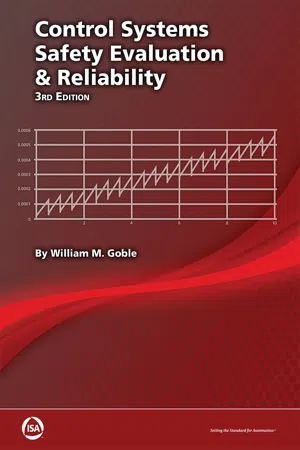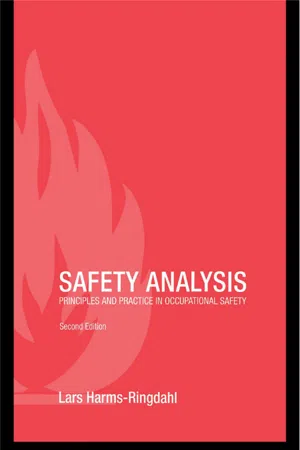Fault Tree Analysis
Fault Tree Analysis is a systematic approach used to identify and analyze potential causes of system failures. It involves creating a visual representation of all possible fault scenarios that could lead to a specific undesired event. By breaking down complex systems into individual components and analyzing their interdependencies, Fault Tree Analysis helps engineers and analysts understand the root causes of failures and develop effective risk mitigation strategies.
8 Key excerpts on "Fault Tree Analysis"
- eBook - ePub
Aircraft System Safety
Assessments for Initial Airworthiness Certification
- Duane Kritzinger(Author)
- 2016(Publication Date)
- Woodhead Publishing(Publisher)
...4 Fault Tree Analysis Abstract Any sufficiently complex system is subject to failure as a result of one or more subsystems failing. The aim of the Fault Tree Analysis (FTA) is to use deductive logic to understand all the underlying causes of a particular failure so that the likelihood of failure can be reduced through improved system design. Keywords Basic events; Common cause factors; Cut set; Deductive logic; Development assurance; Failure probability; Fault Tree Analysis; Functional independence; Gates; Human hazard; Item development independence; Model; MTBF; Reliability; Safety targets; Single point failure; System architecture; Validating; Verification The greatest of faults, I should say, is to be conscious of none. Thomas Carlyle (1795–1881) 4.1. Introduction A system is a collection of components in a defined architecture with the sole purpose of accomplishing that system’s function (refer to Fig. 3.1). The functional failure probability of that function is determined by the integrity of the constituent components as well as the logic of the systems’ architecture. The more complex the system, the more there is a need for an in-depth analysis technique to identify all possible combinations of failure that could result in loss of the system’s integrity. The Fault Tree Analysis (FTA) is such a technique. A fault tree 1 shows graphically, by means of a specified notation, the logical relationship between a particular system failure and all its contributing causes. This chapter considers the manner in which an FTA is used to show how an undesirable top-level failure (or event) may occur via the combination(s) of individual contributing failures, events and/or errors. In doing so, this chapter provides a simple process (in Fig. 4.1) on how to approach and manage the FTA process. The reader is encouraged to review the reference material for more specialist details on the intricacies of drawing an actual fault tree. 4.1.1...
- William Goble(Author)
- 2010(Publication Date)
- International Society of Automation(Publisher)
...6 Fault Tree Analysis In contrast to FMEA, Fault Tree Analysis (FTA) is a “top down” approach to the identification of system problems. It was developed by H. A. Watson of Bell Laboratories in 1961–1962 as part of the Minuteman missile program (Ref. 1). Fault trees were created as a qualitative tool to help identify design problems in complex systems. Fault trees are complementary to FMEA in that they require a deductive approach to problem identification. A fault tree is very good at pinpointing weaknesses in a system and helps identify which parts of a system are related to a particular failure. The end result of a Fault Tree Analysis is a diagram that graphically shows combinations of events that can cause system failure in an identified failure mode and helps the analyst focus on one failure at a time. A fault tree, when well done, can also be a valuable engineering document describing how the system is supposed to operate under various fault conditions. This provides necessary documentation for more detailed reliability and safety analysis (Ref. 2). While it is true that fault trees are used primarily during engineering design to help identify potential design weaknesses, fault trees can also be of great value when investigating causes of failures or accidents. All of the trigger events and contributing events can be documented in a graphical format showing the overall relationship between events and a resultant failure. Fault Tree Process When FTA is applied to system design, the process starts by identifying a problem, or “system failure event.” The fault tree review team must then study system operation and develop a good understanding of how the system is supposed to work. Knowing how the system is supposed to work, the review team then tries to find all possible ways in which a particular problem could occur. For each item identified, the process continues until trigger events or basic faults are identified on the chart...
- He Ren, Xi Chen, Yong Chen(Authors)
- 2017(Publication Date)
- Academic Press(Publisher)
...Engineers from airlines and manufacturers can evaluate the reliability of the structure and the damage severity through extended quantitative analysis. 6.2. Basic principles of Fault Tree Analysis FTA is one of the most important logic and probabilistic techniques used in probabilistic risk assessment and system reliability assessment. It was first developed by AT&T’s Bell Laboratories in 1962. Later in 1974, US Atomic Energy Commission published a report on risk assessment of nuclear power stations, in which FTA was extensively and effectively used and the development of FTA was promoted greatly since then. FTA is a deductive, “top-down” system evaluation process that focuses on one particular undesired event and possible causes through a qualitative model. The analysis starts with an undesired event with top-level hazard and identifies all credible single faults and faults combinations at the subsequent level that lead to the top event in a systematic pathway. Then the analysis continues through successive levels until a basic cause is unfolded or until the specific requirement is met. Basic cause events are such events that cannot be further broken down, which may be malfunctioning from the system inside or from external damage [48]. In other words, a fault tree is a graphic model of the pathways in a system leading to a foreseeable, undesirable fault event. Events and conditions that contribute to the undesirable event are interconnected through various logic symbols along the pathways to reflect their cause-and-effect relationship...
- eBook - ePub
Bowtie Methodology
A Guide for Practitioners
- Sasho Andonov(Author)
- 2017(Publication Date)
- CRC Press(Publisher)
...7 Fault Tree Analysis 7.1 Introduction Fault Tree Analysis (FTA) is a method that is used not only in science but also in manufacturing industry and many other areas (aerospace, nuclear, medicine, chemical, pharmacy, criminology, etc.). It is a method that was developed in 1962 by H. A. Watson from Bell Laboratories (USA) with the purpose of evaluating the Launch and Control System of Minuteman I missiles. Soon, the benefits of the FTA were recognized by Boeing (one of the companies that worked on the Minuteman missiles) and they started using it for their design and production process for their aircrafts. In the next 10 years, FTA spread in many areas, and it is also extensively used today. The FTA investigates potential faults in complex systems by taking into consideration their mechanisms, modes, and effects and is usually used to quantify their contribution to the overall system failure (Main Event). It is best to start with the FTA during the design process because if the FTA shows that something is unreliable during design, it can be fixed without much effort and cost. Speaking from the point of view of Logic, * the FTA is a deductive approach of analyzing the systems operations. It goes from the general to the particular or as it is well known, as the “top–down” approach. It is a scientific approach when you are proposing a theory and looking for the data that will prove that your theory is correct. And here we have a problem. If you do not find the data that will prove your theory is correct and if the data that are available are not enough to show you that your theory is wrong, then there is a problem. Let me explain this a little bit simply: The deductive approach is used by detectives to solve a crime. † Let us say they are starting from a particular event (murder) when there is a dead body of a person...
- B.S. Dhillon(Author)
- 2020(Publication Date)
- CRC Press(Publisher)
...Thus, it highlights all possible failure causes at all possible levels associated with a system under consideration as well as the relationship between causes. FTA can be used to analyze various types of reliability, maintainability, and safety-related problems. Nonetheless, the main objectives of performing FTA are as follows [ 1, 3 ]: To comprehend the functional relationships of system failures. To verify the system’s ability to meet its imposed safety-related requirements. To understand the degree of protection that the design concept provides against the occurrence of failures. To meet jurisdictional-related requirements. To highlight cost-effective improvements and critical areas. There are many prerequisites associated with FTA, the six main ones are as follows [ 1 ]: Clearly defined analysis objectives and scope. Clear identification of all related assumptions. Clear definition of what constitutes system/item failure: the undesirable event. Clear understanding of design, operation, and maintenance aspects of system/item under consideration. Clearly defined system/item interfaces and system/item physical bounds. A comprehensive review of system/item operational experience. FTA uses various types of symbols, and four commonly used symbols in fault tree construction are shown in Fig. 4.1 [ 9 ]. The circle denotes a basic fault event or the failure of an elementary part/component. The event’s occurrence probability and failure and repair rates are generally obtained from empirical data. The rectangle denotes a fault event that results from the combination of fault events through the input of a logic gate. The AND gate denotes that an output fault event occurs only if all the input fault events occur...
- eBook - ePub
Safety Analysis
Principles and Practice in Occupational Safety
- Lars Harms-Ringdahl(Author)
- 2001(Publication Date)
- CRC Press(Publisher)
...9 Fault Tree Analysis 9.1 INTRODUCTION A fault tree is a graphical representation of logical combinations of causes of a defined undesired event or state. Examples of types of final events are an explosion, failure of equipment, the release of toxic gas and an interruption to production. Fault Tree Analysis (FTA) is perhaps the best known method employed in safety analysis. It started to be used in the 1960s. The method is of greatest value for complicated technical systems where a functional failure can have serious consequences, and also where considerable resources can be allocated for hazard analysis. The method is relatively difficult and is generally used by specialists. There is an extensive literature on the method (e.g. IEC, 1990; Kumamoto and Henley, 1996; Lees, 1996), and a number of computer programmes are available to aid the design of fault trees and make calculations. It can be questioned whether the method is appropriate for common safety work outside high-risk sectors. But a general knowledge of Fault Tree Analysis is useful even for those who will not use the method directly. The purpose of the description given here is to acquaint the reader with the method and provide a basis on which simpler kinds of fault trees can be generated. However, probabilistic estimates, which form an important area of application in Fault Tree Analysis, are only briefly referred to. To some extent, the traditional focus of Fault Tree Analysis has been extended...
- eBook - ePub
- Bijan Elahi(Author)
- 2018(Publication Date)
- Academic Press(Publisher)
...Chapter 12 Risk Analysis Techniques Abstract Identification of hazards for risk analysis can be done using various tools. Two of the most common tools are Fault Tree Analysis (FTA) and Failure Modes and Effects Analysis (FMEA). In this chapter three types of FMEA are discussed: DFMEA, PFMEA, and UMFMEA. Additionally, two other tools are presented: Mind Map Analysis and P-Diagram. Ultimately it is the analyst's choice on how many tools to use. While extra analyses consume more resources, they also reduce the likelihood of missing some Hazards and their causal chains. Keywords Fault Tree Analysis; FTA; Failure Modes and Effects Analysis; FMEA; DFMEA; PFMEA; UMFMEA; Mind Map Analysis; P-Diagram 12.1 Fault Tree Analysis 12.1.1 Introduction The Fault Tree Analysis (FTA) technique was developed by Bell Labs in 1962 for use on the Minuteman missile system. Later it gained wide use in civil aviation, space, and military applications. MIL-HDBK-338B published in 1998 provides a reference for this technique. After the 1979 incident at Three Mile Island, the Nuclear Regulatory Commission expanded the use of FTA and published NUREG-0492— Fault Tree Handbook in 1981. This handbook was later updated by NASA in 2002 with the title Fault Tree Handbook with Aerospace Applications [24]. FTA is a deductive top-down reasoning process that starts from the undesired system outcomes and attempts to find out all the credible sequences of events that could result in the undesired system outcomes. The fault tree is a graphical model that depicts the logical relationships among the parallel and sequential combination of events that could lead into the event at the top of the tree. FTA can model both normal and fault conditions, under various environmental and operational scenarios. FTA can also identify and model fault dependencies, and common cause failures (CCFs). Fault Trees (FTs) are constructed using logic gates, such as AND and OR gates...
- eBook - ePub
Aircraft Systems
Mechanical, Electrical, and Avionics Subsystems Integration
- Ian Moir, Allan Seabridge, Roy Langton(Authors)
- 2011(Publication Date)
- Wiley(Publisher)
...This analysis technique uses probability to assess whether a particular system configuration or architecture will meet the mandated requirements. For example, assume that the total loss of aircraft electrical power onboard an aircraft has catastrophic failure consequences as identified by the Functional Hazard Analysis – see Figure 11.2 and Table 11.1 above. Then the safety objective quantitative requirement established by FAR/JAR25.1309 and as amplified in ARP 4754 will be such that this event cannot occur with a probability of greater than 1 x 10 -9 per flight hour (or once per 1000 million flight hours). The ability of a system design to meet these requirements is established by a FTA which uses the following probability techniques. In the example it is assumed: That the aircraft has two independent electrical power generation systems, the main components of which are the generator and the Generator Control Unit (GCU) which governs voltage regulation and system protection The aircraft has an independent emergency system such as a Ram Air Turbine (RAT) That the failure rates of these components may be established and agreed due to the availability of in-service component reliability data or sound engineering rationale which will provide a figure acceptable to the certification authoritiesThe FTA analysis – very much simplified – for this example is shown in Figure 11.6. Figure 11.6 Simplified FTA for an aircraft electrical power system Starting in the bottom left hand portion of the diagram: the Mean Time Between Failure (MTBF) of a generator is 2000 hours – this means that the failure rate of Generator 1 is 1/2000 or 5.0x10 –4 per flight hour. Similarly if the MTBF of the generator controller GCU 1 is 5000 hours then the failure rate of GCU 1 is 1/5000 or 2.0x10 -4 per flight hour. The combined failure rate gives the probability of loss of electrical power to Main Bus 1...







